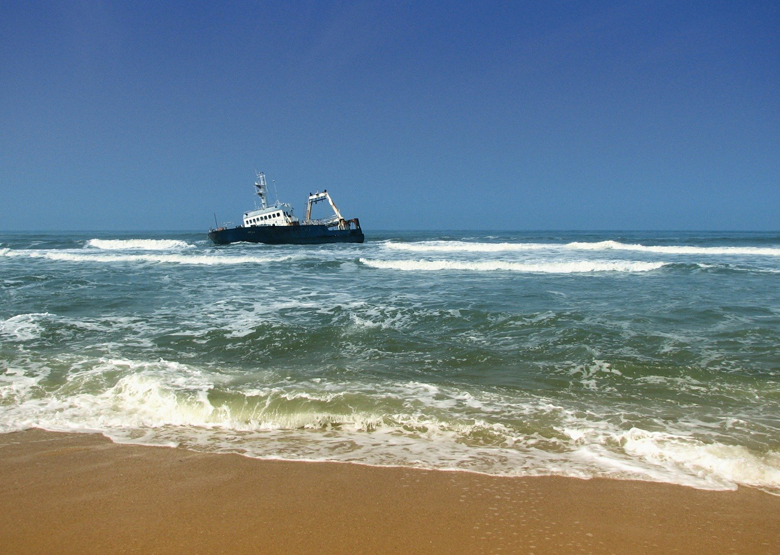The Skeleton Coast is called the northern part of Namibia’s Atlantic coast in the section south of the mouth of the Cunene River at the Angola border to the mouth of the Swakop River at Swakopmund.
Sometimes the name is also used in the interior of the Namib Desert. The Bushmen called this place “God created the earth when he was angry,” and Portuguese sailors called it “The Gate to Hell.”
Its name comes from the skeleton coast of hundreds of shipwrecks and whale bones that have been rotting for centuries in the hot sand. Thick wafts of mist through the cold Benguela current, violent surf and treacherous currents were doomed to seafarers and pilots as well as passing whales. Shipwrecked people who could save themselves on the coast were not really saved – there was no chance of survival in the hundreds of kilometers of sandy desert behind the coast.CNN recently called it the end of the earth.
The southern part of the skeleton coast enters the tourist area on the west coast. The fish-rich ocean attracts a large number of fishermen, who often organize large fishing camps. The section north of Tora Bay Bay to the Angola border is included in Skeleton Coast National Park and access is restricted.
The fish-rich coast attracts not only people. Large colonies of South African seals live along the Atlantic coast. The number is more than 100,000. Only Cape Cape Cross colony is allowed for tourists to visit. Despite the extremely hostile environment for life on the Skeleton,
Today The skeleton coast attracts the most adventurous surfers: Geographical isolation, difficult terrain, cold and shark-infested waters, strong currents, thick fogs, and unpredictable weather conditions. Surfers generally prefer to practice around Swakopmund and Walvis Bay. According to the site Magicseaweed.com, the practice of surfing is now prohibited on the coast after several intrepid surfers have not respected the established safety rules.
Access : Coordinates: -21.612222, 14.54 / The main coastal road (C34) starts at Swakopmund and follows the coast north up to the Ugab River mouth.An alternative route is west from Khorixas.
Highlights :
- Skeleton Beach National Park : The northern part of the coast between the mouth of the Ugab River and its extension to Angola by the River Kunene has been declared a Skeleton Coast National Park. Its area is 16000 km² and is managed by the Ministry of Environment and Tourism. The territory of the park is divided into two zones north and south. Tourists’ access to the southern part of the section between the Ugab and Hoanib Rivers is completely free, while in the north the visits are severely restricted. Travel groups only come here with a licensed tour operator, adhere to strictly defined conditions of stay without spending the night at their place of visit.
- The legendary desert elephants : The skeleton shore phenomenon is also represented by desert elephants. They became legendary for locals mentioning that they had seen elephants at such an extremely harsh place to live. Scientists have denied this claim for a long time due to the fact that such a huge animal is almost impossible to survive and live under such conditions.
- Boat cemetery :The Skeleton coast is dotted with stranded wrecks, accidents mainly due to the thick mists that regularly reach the coast. Among these wrecks, the Winston (failed in 1970), the Henrietta (failed in 1968), the Montrose II (failed in 1973) .
In April 1999, the Namdeb Diamond Corporation exploring offshore discovered a Portuguese ship dating from the 16th century and containing a treasure of $ 100 million in gold coins, ingots, elephant tusks, tin and copper ingots, and weapons. - Ocean coast : Coastal sand dunes, where there is almost never rain and green plants can not survive, are sometimes covered with large fields of brown lichens, which receive moisture from the dew falling in the morning. Where even lichens do not grow, there is an ecosystem of mosquitoes that feed on the decay products of plant and animal tissues brought by the wind from the continent, and reptiles that feed on mosquitoes.
- Seal rookery at Cape Cross : With a large number of fish, the Skeleton Coast attracts not only people: huge herds of South African fur seals (also called eared seals), numbering over 100,000 animals each, inhabit traditional seal rookeries along the entire Atlantic coast of Namibia.
- The Bushmen of the Namibian interior called the region “The Land God Made in Anger”, while Portuguese sailors once referred to it as “The Gates of Hell”.
- The Skeleton Coast, the book that gave name to this region cursed by navigators, was published in 1944. Its author, historian John Henry Marsh, rebuilt one of the most spectacular maritime rescues of the last century , the British freighter Dunedin Star.
- Activities : sail , The Skeleton coast is considered to be prime sail angling area / trekking, the Ugab River Hiking Route, which takes around 50km along the river for three days./ visit some of the wrecked ships / safaris to see lions and desert elephants.
Go next : Terrace Bay – “Roaring Dunes of Terrace Bay” / Torra Bay, a paradise for passionate fishermen / the “Burnt Mountain”, a pitch-black rock made of basalt pillars similar to organ pipes.

